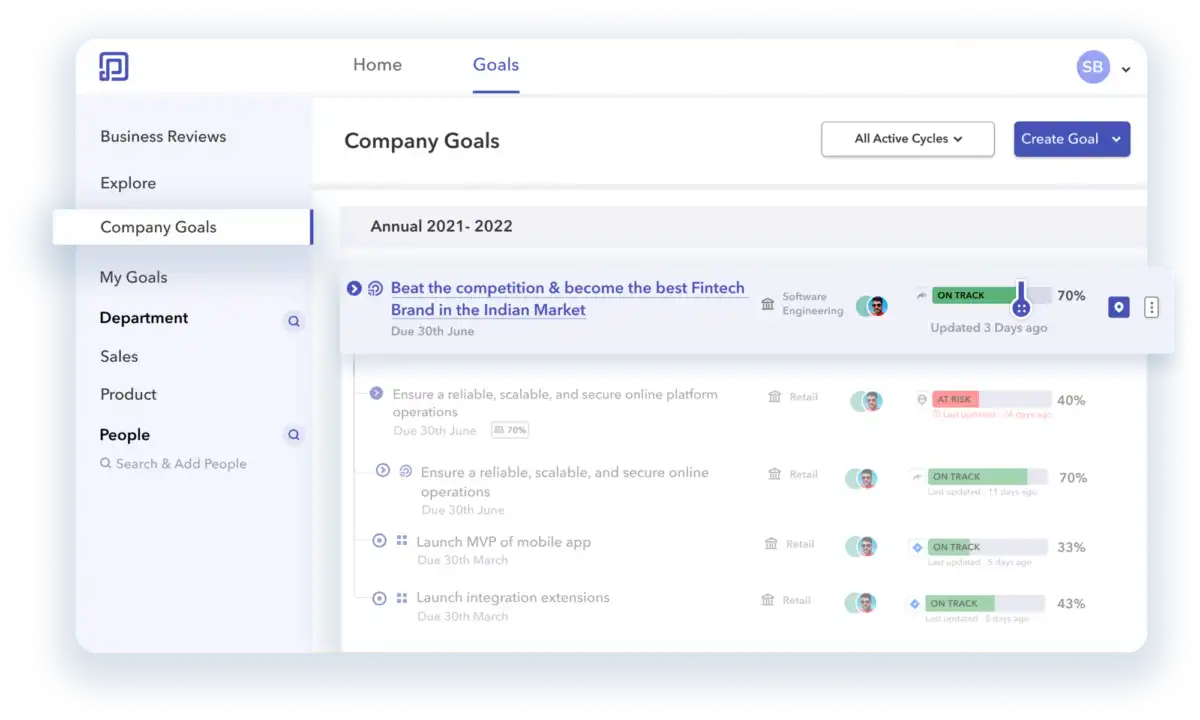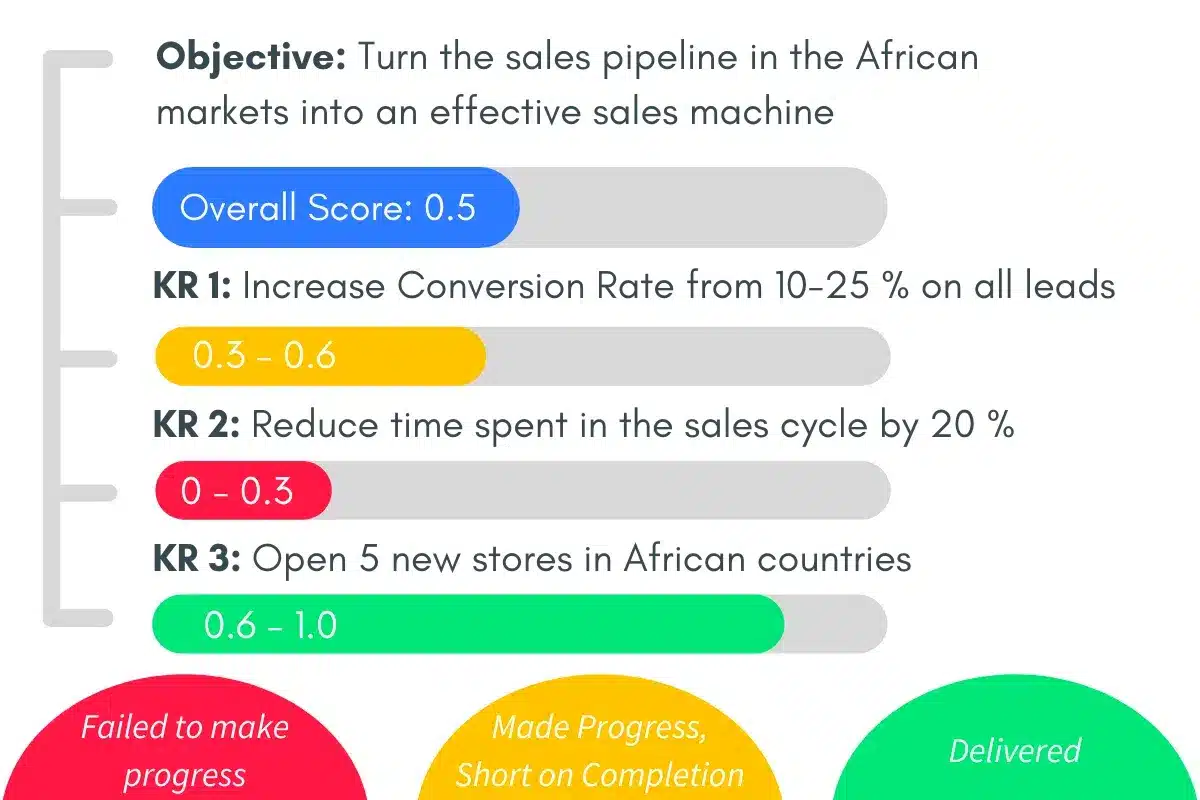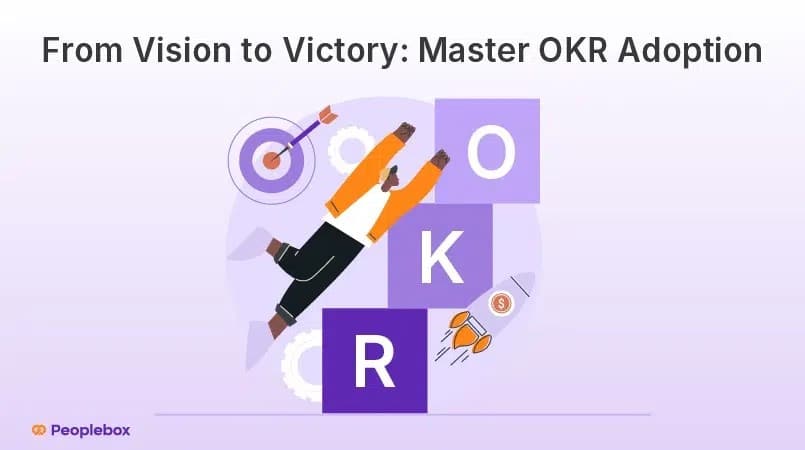Did you know that John Doerr in his book “Measure What Matters” stated that “95% of OKR users in the US knew how their work aligned with the company they worked in as opposed to 79% of people who were non-users”?
OKRs are an effective solution for businesses because it helps them stay aligned with the goals of their organizations. Even giants like Google, Microsoft, and Amazon consider OKR to be an efficient goal setting methodology for their business process.
But to truly assess the power of OKR, you shouldn’t miss out on Allbirds. The company started its journey with the belief to manufacture sustainable footwear for all. They called them KIWI or Keep Improving With Intent.
Allbirds decided to use OKRs to achieve this mission and produce carbon-neutral shoes. They tracked carbon emissions across all points of their chain, from raw materials and transportation to manufacturing finished products. Once they tracked down the carbon footprint to the gram of CO2 per shoe, Allbirds was able to offset emissions accurately and achieved 100% carbon neutrality.
They were able to drive success with OKR adoption. And, so can you. With our blog, you will learn how to:
- Adopt OKRs by setting them the right way
- Best practices for successful OKR adoption
- Mistakes to avoid for successful OKR implementation
Without further delay, let’s dive in!
What Are OKRs? Why Are They Important?
OKR is a goal-setting methodology driving strategy execution. It provides clarity of goals and a unified direction for the entire organization to work. It has two main components: Objectives and Key Results. Objectives define the ultimate goal of where the company wants to be and the key results define how the company plans to be there.
Companies use OKRs to solve problems that stop them from achieving their ultimate goals. Some of the problems that companies face when they set goals without any concrete plan and process are:
- Forgetting goals set at the beginning of the year
- Aligning teams and cascading goals
- Difficulty in managing, measuring and tracking progress in real-time
- Setting clarity of role and its importance among employees
In a nutshell, OKRs combat these problems and provide a robust system to set, evaluate, measure, and track goals with complete transparency and visibility for everyone in the company.
It brings along with it the following list of benefits:
- Better visibility of strategic priorities
- Goals aligned across the organization
- A clear direction to employees
- A tracking process to ensure everything is working perfectly
- Better accountability process
- Boost in productivity, engagement and empowerment
- Captures cross-functional dependencies
- Finds the cause of failure and analyzing it
How to Set OKRs?
Now that we have understood why companies adopt OKRs, it is time to learn how you can take advantage of this effective method. But, you must ensure tailoring OKRs according to your needs and context. Because what worked for Intel might not work for you. So, be wise, and do not copy OKRs.
There are several ways to drive OKR adoption in your organization. All you have to do is customize these according to your organizational context.
1. Drafting an OKR plan to set priorities
The first step to implementing OKR is by developing an OKR plan. It includes setting priorities and finding the top goals after collective brainstorming. Your OKR plan must have moonshot goals that are close to achieving but still a little hard to complete. Also, validate them before sharing them with the team.
Use software
One of the challenges that companies face when implementing OKRs is that they attempt to set goals using a static method like spreadsheets or PPTs. It restricts the visibility of the goals for everyone. It restricts communication and connecting tasks with OKRs. There is no way to measure the progress and analyze the shortfalls.

However, the use of OKR software can help you rectify the situation. OKR solutions like Peoplebox enable its users to set the right OKRs with the right metrics. They can be tracked easily and teams can be onboarded hassle-free. What’s more, you can also find other useful functionalities like analysis, report, scheduling, 1:1s, business reviews, etc.
Test OKR with a small team
When you implement OKR for the first time, it is better to test it with a small team first. While OKRs are effective, it requires training the team to use the methodology to get the results. When you try with a small team, you will be able to identify what works best. You can take feedback from the team to improve the process.
OKR plan focus
Whenever you plan your OKR, keep these in mind.
- Cadence: Remember that organizational goals are set with a mission in mind and are usually an annual achievement. Departmental and team goals are set quarterly for maintaining agility.
- Accountability: Establish clear responsibilities for the implementation and management of OKRs.
- Agility: Use software that allows quick changes, as and when required to keep your organization moving forward.
2. Aligning OKRs with the company through regular communication
OKRs follow a bi-directional approach meaning it adopts a top-down and bottom-up approach. Creating bi-directional alignment ensures that the managers assign and communicate OKRs with the teams and individuals. This allows individual team members to align their OKRs towards the company goals. This alignment improves collaboration and communication, boosts engagement and growth, and helps measure the impact of each OKR.
3. Educating the teams about OKR implementation and onboarding
This is the execution stage, where your OKR strategy comes into action. For the company-wide implementation of OKR, you will need all the help you can get and all the cooperation from your employees.
Good software always comes with a customer success team that helps in company-wide OKR implementation. The implementation process involves educating the teams, beginning with the leadership team. When everyone has understood the method and is on board the platform, measurable goals are set for everyone in the OKR.
5 Mistakes to Avoid When Using OKRs for Strategic Planning in 2023
4. Reviewing OKRs through effective business review
It is an important step where you identify the roadblocks, find solutions, make fast decisions and bridge the gap between strategy and execution.
5. Making sure OKRs work
You have aligned and trained everyone, and checked for any gaps in your strategy till the execution process. But that isn’t enough. Make sure you conduct regular check-ins to ensure your OKRs work. You must include regular retrospective meetings with teams to ensure they are focused and the KPIs are in place. You can use the software features like progress reports and recommendations to discuss upcoming obstacles and opportunities.
6. Scoring OKRs

This step sets you up for success in the coming OKR cycles. By setting time aside for regular review of OKR performance, analyzing the data points is crucial to understand the performance of team members. Set 1:1 meetings to discuss progress against objectives, what could have been done differently, how teams can ensure better performance next time, etc. This exercise opens up a healthy conversation focused on individual and company growth.
Best Practices for OKRs
Successful implementation of OKRs also depends on adopting the best practices that have helped companies achieve results with OKRs. Some of them to keep in mind are:
1. Focus on FAVA
FAVA stands for Focus, Alignment, Visibility and Accountability. All these points together ensure a robust strategy execution, and when these couples together with an efficient platform, you get the best possible results. This brings strategy, teams and data together for optimizing operations, faster decision making and driving better outcomes.
2. Set quarterly goals
It is recommended to set quarterly goals, and align them with long-term company goals. This ensures that the teams don’t lose sight of the goals and have a razor-sharp focus.
3. Weekly Cadence
Once you have set OKRs, set weekly cadence and make it a part of your routine. It is recommended that you measure your progress weekly, update it and schedule weekly discussions with teams to ensure everyone is proactive and on the same page.
4. Extra Attention to alignment
While we have already told you about aligning goals, it is crucial that we remind you to pay extra attention to ensure that everyone in the company is aware, and has set OKRs aligned with company goals. Ensure aligning the different objectives at all levels of the organization.
5. Bi-directional OKRs
The best OKRs do not cascade only from top to bottom. When setting OKRS, include each individual to build tactical OKRs aligned with strategic OKRs. This creates an efficient process where everyone feels involved and responsible for the OKRs.
Common Mistakes and How to Avoid Them When Setting OKRs
Apart from the above points, when implementing OKRs, you must avoid these mistakes that people make.
1. Turning KPIs into OKRs
A typical mistake that people make-taking KPIs and turning them into OKRs. When you do this, the goals lose ambition. Remember that OKRs are ambitious and moonshot goals created with the larger company goal in mind, while KPIs are tailored around the operational activities of the company.
2. Adopting only a top-down approach
Following only a top-down approach limits creativity and autonomy. Which in turn, negatively impacts performance by demotivating the employees. Avoid brainstorming OKRs in silos and include suggestions and ideas from the respective team members.
3. Not tracking OKRs
Setting OKRs and forgetting them is another common mistake you must avoid. Tracking OKRs regularly ensures that corrective actions and realignment happens on time. These become difficult when you don’t track your OKRs.
4. Launching initiatives without measurable metrics
Initiatives are tasks or projects that help achieve the KRs. When you launch an initiative with some measurable metrics, you ensure that your initiatives drive the results they intended to.
5. Not separating personal goals from team OKRs
Setting personal goals is encouraged but it should always be separate from team OKRs. Personal achievements at work are often used as metrics during appraisals, promotions, bonuses, etc. Avoid setting personal OKRs and set team OKRs with the team’s objective in mind.
6. Creating OKRs in Excel
While it might seem the right idea to embark on the OKR journey with an Excel sheet, it fails to bring the results. This is so because it involves a lot of manual work to set OKRs using an Excel sheet– creating OKRs for different departments, and teams, then integrating them, etc. You also don’t get to track the progress.
When you use a tool designed specifically for OKR implementation, it automates a lot of redundant tasks like formats, creating interconnectivity of tasks of different departments, providing visibility to the entire organization, etc. The tool also lets you track and measure progress, creates reports, allows you to integrate other tools into your OKR workflow and brings so many other features that ease your OKR implementation. Peoplebox is one such tool that makes OKR implementation a piece of cake for organizations with its robust tool and implementation support.
Final Words
Implementation of the OKR methodology might feel intimidating at first. When you follow the right steps, you will start to see the benefits OKRs brings to your organization. It connects people, motivates them, creates a mutual growth environment for everyone and prepares you to operate in the uncertain business environment we have now.
OKRs don’t discriminate based on the size of the organization and with tools like Peoplebox, you can streamline your implementation strategy quickly.






